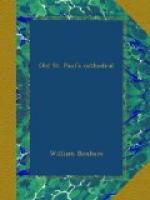Dugdale also tells of “a picture of St. Paul, richly painted, and placed in a beautiful tabernacle of wood on the right hand of the high altar in anno 1398, the price of its workmanship amounting to 12_l._ 16_s._”
Quoting from a MS. of Matthew of Westminster, he gives the dimensions of the church, in the course of which he says the length was 690 feet. This is undoubtedly wrong, as Wren showed. I take the measurements from Mr. Gilbertson’s admirable little handbook, who, with some modifications, has taken them from Longman’s Three Cathedrals.
Breadth
104 ft.
Height of Nave roof to ridge of vaulting
93 ft.
" Choir
101 ft. 3 in.
" Lady Chapel
98 ft. 6 in.
" Tower from the ground
285 ft.
" Spire from parapet of tower
204 ft.
" Spire from the ground
489 ft.
Length of church (excluding Inigo Jones’s porch)
586 ft.
Wren (Parentalia) thinks this estimate of the spire height too great; he reckons it at 460 feet.
The cathedral resembled in general outline that of Salisbury, but it was a hundred feet longer, and the spire was sixty or eighty feet higher. The tower was open internally as far as the base of the spire, and was probably more beautiful both inside and out than that of any other English cathedral. The spire was a structure of timber covered with lead. In Mr. Longman’s Three Cathedrals are some beautiful engravings after a series of drawings by Mr. E.B. Ferrey, reproducing the old building. There is one curious mistake: he has not given at the base of the spire, the corner pinnacles on the tower, which were certainly there. They are clearly shown in Wyngaerde’s drawing of London, and on a seal of the Chapter, which we reproduce. Some time later than the rest of the work, stately flying buttresses were added to strengthen the tower walls. One special feature of the cathedral was the exquisite Rose window at the east end, of which we give an engraving. It had not a rival in England, perhaps one might say in Europe. Inigo Jones, if he was really the architect of St. Katharine Cree, made a poor copy of it for that church, where it may still be seen.
Of great historical events which had occurred during the growth of St. Paul’s cathedral we have to speak hereafter. As the momentous changes of the sixteenth century drew near, the godlessness and unbelief which did so much to alienate many from the Church found strong illustrations in the worldliness which seemed to settle down awhile on St. Paul’s and its services. Clergymen appeared here to be hired (Chaucer’s Prologue), and lawyers met their clients. Falstaff “bought Bardolph at Paul’s.” But before we come to the great changes, it will be well to go back and




